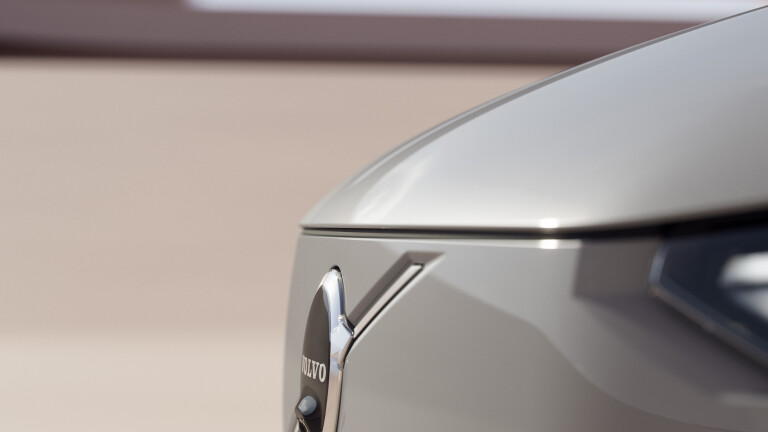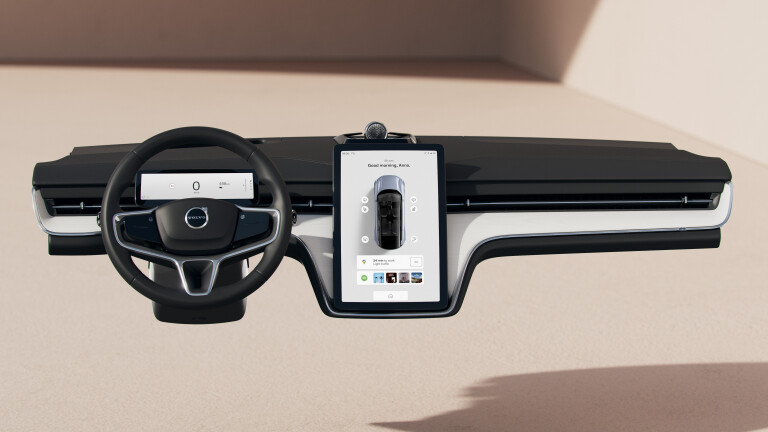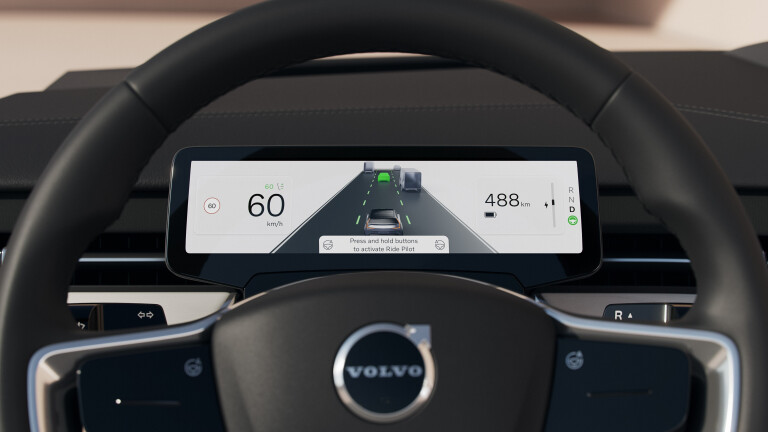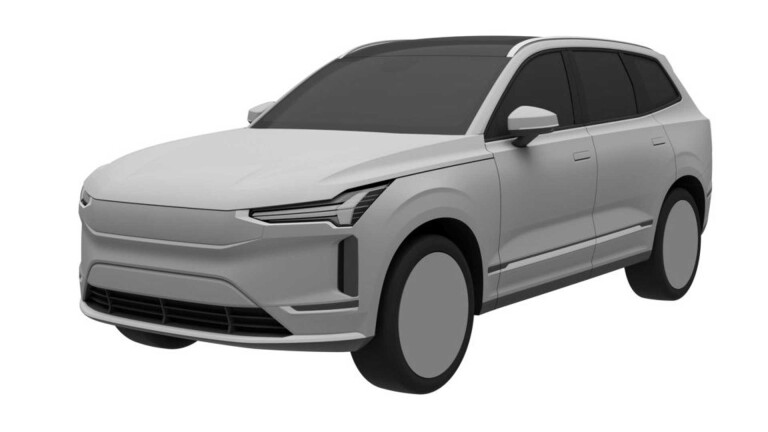
With only seven days until Volvo reveals the 2023 EX90 to the world, the brand has drip-fed more info – including that designers were inspired by yachts.
Today’s big reveal, though, is the EX90’s aerodynamic efficiency, which Volvo says is 0.29Cd – very competitive for a seven-seat vehicle. For reference, an Audi Q7 weighs in at 0.36Cd.
This announcement follows the reveal of the EX90’s interior, charging capabilities and new safety systems.

We also get a glimpse of some finer details, including the seamlessly integrated lidar sensor in the roof, flush glazing, integrated doorhandles, aerodynamic alloy wheels and clamshell bonnet. Not only do these details aid efficiency, but they also look super slick.
“We’ve taken inspiration from yacht design to outline the Volvo EX90’s beautiful and sleek proportions,” said Volvo head of exterior design, T. Jon Mayer.
“If you look at the front, it’s proud and confident – inspired by a sailboat’s ability to shear through the ocean’s slamming waves. But it’s also rounder overall, which enables the air to flow around the car more efficiently.”

We also now know a panoramic sunroof – like in Polestar 2 – will be standard to let light in during gloomy Scandinavian winters. Volvo also says it’s paid particular attention to ambient lighting in the 2023 EX90 for the same reason.
The Volvo EX90 will be fully revealed on November 9, 2022.
Our original story, below, continues unchanged.
The Story To Here
October 26, 2022: Volvo EX90 interior revealed
Volvo has released a set of teaser images showing the cabin of the 2023 EX90 large SUV and they hint at a possible 500 kilometre-plus driving range.
The cabin design is ultra-minimal, one could argue it’s borrowing from Tesla or simply an evolution from the current infotainment in the XC40 and XC60 SUV ranges.
Instead of a digital driver’s display nestled in a binnacle, the EX90 transitions to an ultra-short widescreen ahead of the steering wheel bringing more light into the cabin.

The screen's graphics are minimal yet legible. Volvo says the aim is “to present what you need in a simplified way.” The screen also gives real-time readouts of what the assisted driving features can detect.
Aside from the design, there is an easter egg on screen that could hint at the EX90’s capability. This is certainly an electric vehicle, and with about 90-95 per cent battery showing on the screen 488km of driving range is estimated.
Though of course, these images are just renderings, not the real thing.

Volvo is yet to claim battery size of WLTP driving range for the 2023 EX90, but if the images have any tie to reality then this large SUV will be well equipped on the range front.
In the centre, the portrait touchscreen looks larger than any fitted to a current Volvo product, but the brand has not quantified its size yet. It also appears to be running an updated version of Android Automotive software currently in Volvo and Polestar products.
The EX90’s centre screen gives access to drive modes, external information, media control and Google Maps navigation. Atop the dashboard is Volvo's signature Bowers and Wilkins sound system, so the EX90 won't compromise on the XC90's excellent audio quality.
Full details will be revealed on the EX90’s November 9 release date.
Our original story, below, continues unchanged.
The story to here
October 9: 2023 Volvo EX90 to offer bi-directional charging
The 2023 Volvo EX90 electric SUV will feature another brand-first: bi-directional charging.
As Volvo moves closer to the reveal of its new flagship SUV on November 9, it has revealed the EX90 will support vehicle-to-load (V2L) and vehicle-to-grid (V2G) technology.
It will be initially available in selected markets, with the EX90 capable of powering homes and “other electric devices”, such as portable appliances.
“You could use its battery in many ways, from topping up your electric bike when you’re out and about, to hooking up an outdoor cooking appliance for your weekend camping trip,” said Olivier Loedel, head of the electrification ecosystem at Volvo.
“It could even power your house during the expensive peak hours of the day.”
The charging process will be automatic and managed within Volvo’s smartphone app, with algorithms designed to reduce the risk of potential battery degradation from the vehicle acting as a power bank.
In addition, Volvo claims using the EX90 to power your home could be beneficial during peak periods when electricity prices are higher, following a prior top-up during off-peak times.
Our original story, below, continues unchanged.

September 21: 2023 Volvo EX90 to debut new safety tech
“[LiDAR offers] vision beyond the human range by day and by night.”
The 2023 Volvo EX90 electric SUV, to be sold alongside the current XC90, will be revealed on November 9.
Previously expected to wear eXC90 or Embla badging, the Swedish luxury marque, owned by China’s Geely, has now confirmed its latest flagship SUV will be called EX90 and offer full self-driving technology.

Volvo has announced new active safety features debuting on the all-electric crossover – and fitted as standard – will include LiDAR sensors and an in-car driver monitoring camera.
The brand’s ‘driver understanding system’ uses two internal cameras to detect when a driver is distracted, tired or intoxicated via specific eye-gaze patterns.
This is achieved through eye tracking designed to recognise a driver’s ‘gaze concentration effect’.
Volvo says a driver's attention level should be around 80 per cent, with 90 per cent or above a sign of cognitive distraction or alcohol intoxication. In comparison, a result below 60 per cent signifies a visual distraction, such as using a mobile phone.
Built from existing driver attention alerts and monitoring cameras, the system also recognises steering behaviour to intervene first by a visual warning.

It will then automatically reduce speed, keep the vehicle in its lane, halt to a stop, and place an emergency call if the driver is impaired.
“We’ve made great progress on exterior sensing in the last decades, thanks to our committed work on crash prevention systems,” said Thomas Broberg, the acting head of Volvo Cars Safety Centre.
“Interior sensing is one of the next safety frontiers for us. We will continue to learn, develop and deploy new features step by step to help improve safety as our knowledge increases and matures.”
Mikael Ljung Aust, a technical specialist at Volvo Cars Safety Centre, said the driver monitoring system is a stepping stone toward unsupervised autonomous driving.

And that will come, with Volvo confirming the EX90’s laser-scanning LiDAR system is compatible with full self-driving. It will be offered via subscription in future – once the technology is approved in selected regions – with over-the-air software updates.
Expect more details on autonomous driving at the EX90’s unveiling in November.
LiDAR – which stands for Light Detection and Ranging – will be standard across the EX90 range, utilising “light in the form of a pulsed laser to measure ranges with high precision and fidelity”.
It will be embedded in the roofline of the EX90, with a 1550-millimetre wavelength bringing the ability to detect pedestrians at a 250-metre distance at highway speeds, even in the dark.

Joachim De Verdier, head of safe vehicle automation at Volvo, said the least dangerous crash is “one that never happens”, with LiDAR technology allowing for a 20 per cent reduction in severe accidents and a nine per cent improvement in crash avoidance.
“[LiDAR offers] vision beyond the human range by day and by night.”
It will be matched with Volvo-developed software and the vehicle’s 'super-computer', likely supplied by technology giant Nvidia – and is a step beyond Tesla’s full self-driving beta, which can only see the road ahead via cameras on the latest Model 3 and Model Y vehicles.

Leaked patent images have revealed the design of the large SUV, featuring a familiar look to the current XC90 but with modern touches, such as tail-lights similar to the Volvo S60 and Polestar 2 sedans and hidden door handles.
With electric power and LiDAR technology as standard, expect the Volvo EX90 to command a significant premium over the XC90, which starts from $92,990 before on-roads in Australia.
The 2023 Volvo EX90 will compete against the Mercedes-Benz EQS SUV, Tesla Model X and Rivian R1S – only the Mercedes-Benz is confirmed for Australia at this stage, with a local launch planned for the first half of 2023.

COMMENTS